Tehran Time Museum: A Journey Through Time
Are you fascinated by the concept of time and how the invention of clocks has transformed human societies and the way we organize our daily routines? If so, then the Time Museum in Tehran is a must-visit destination for you.
Tehran Time Museum is the first museum of its kind in Iran. It offers a collection of clocks, watches, and other measuring devices, ranging from ancient marvels that will leave you in awe of their intricate mechanisms and craftsmanship to the contemporary watches you know today.
The Time Museum was established in 1999 and was registered in the National Monuments List of Iran in 2003. In this blog, we will explore the Tehran Time Museum, including its history, structure, opening hours, entrance fee, location, and how to get there.
History of Tehran Time Museum

The Tehran Time Museum, spanning an impressive area of 5000 square meters, holds a remarkable collection of clocks from ancient times to the present day.
The museum building is over 80 years old, but its garden history dates back to the reign of Naser al-Din Shah Qajar when it was part of the Ferdows Garden, belonging to Mo'ayiralammalek, the son-in-law of Naser al-Din Shah.
After Mo'ayiralammalek's passing, the garden was inherited by his son, who unfortunately felled its trees for fuel in the furnaces of Tehran.
In 1925, Abdullah Khan Mansur acquired the property, which remained in his family's possession until 1967. It was during this time that a man named Hossein Khodadad purchased the property, even though it was only a one-story mansion made of clay and mud.
Under the direction of Hossein Khodadad, renovations were carried out, including the replacement of the wooden skeleton with an iron one and various interior modifications.
Hossein Khodadad resided in the house for only one year before moving to America prior to the revolution. Following the 1979 revolution, the building was seized by the Mostazafan Foundation. In 1999, it was officially inaugurated as the Time Museum, also known as the Clock Museum, under the Cultural Institute of the Foundation's Museums. Since then, it has been open to the public, offering a captivating exploration of time and clocks.
| Related: Best Museums in Tehran
Structure of Tehran Time Museum

The museum has two floors and is structured to ensure a seamless and engaging experience for its visitors, with exhibits spread across the floors. The Museum of Time also has a restaurant, cafe, bathroom, prayer hall, and time gallery (to buy artists' works).
The Tehran contains many clocks, watches, and other measuring devices, including water clocks, hourglasses, sundials, and various clocks that measure time by the progressive burning of an object, such as a candle or rope.
The museum also holds individual clocks and watches owned by notable historical figures. Among these valuable clocks, we can mention the clock of "Professor Mahmoud Hesabi," the sundial of "Nasser al-Din Shah," and the watches of Ahmad Shah Qajar and Muzaffar al-Din Shah.
Documents and tools related to the glorious chronology and its background in Iran are also displayed in this museum, including the astrolabe, one of the oldest astronomy tools.
In addition, you can find a replica of the oldest Iranian historical document (Biston inscription) and Iranian ethnic-religious calendars such as the Hebrew calendar of 5708 Hebrew (1326 AD), the Zoroastrian calendar of 3712, and the Kurdish ethnic calendar of 1987.
| Read more: Top 23 Museums in Iran + Photos
Various Sections of the Time Museum in Iran
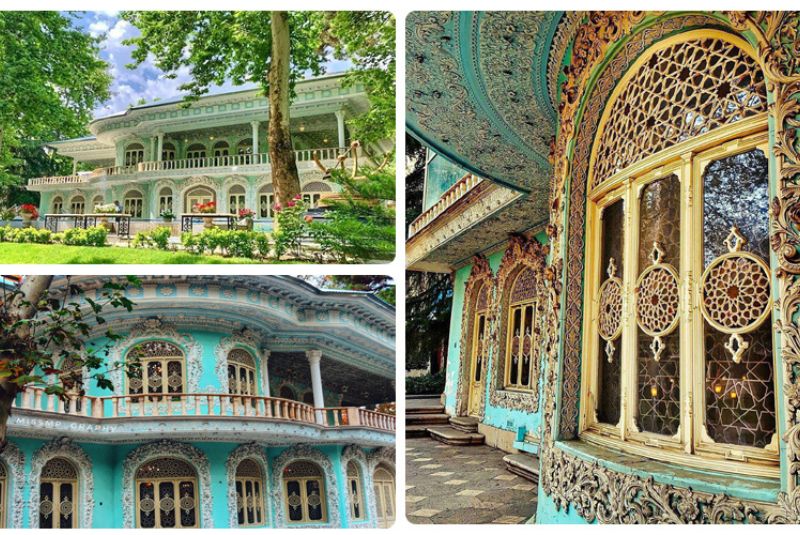
Ground Floor
The museum's ground floor serves as an introduction to the world of timekeeping. Here, visitors can observe various ancient timekeeping devices, each with its own unique mechanism. Here are some ancient timekeeping devices you will find on the ground floor.
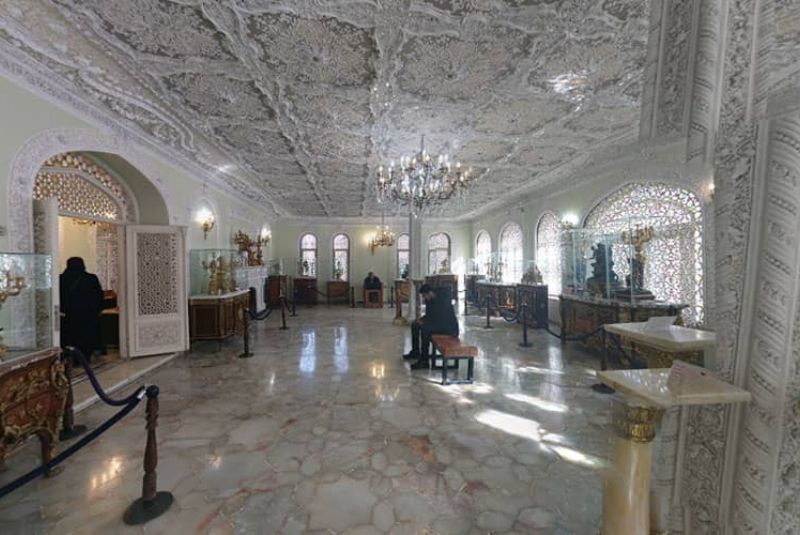
The Water Clock
The water clock was an early timekeeping device. It consisted of a graded container filled with water. As the water flowed through the bottom of the container, people could determine the remaining time by observing the water level.
| Suggestion: Royal Car Museum in Tehran with Vintage Car Collections
Sundial
On the museum grounds, you'll find a sundial, an intriguing tool invented around 5,500 years ago. This type of clock features a wooden indicator that casts a shadow on a horizontal surface, allowing the observer to determine the time based on the position of the shadow. Sundials were widely used in Europe until the 18th century and can still be found in some churches and old houses.
Mechanical Water Clock
Mechanical water clocks were developed following the water-based timekeeping methods. These clocks featured two tanks where water would flow from the top tank to the lower one. Inside the lower tank, a float connected to gears would rise as the water level increased, resulting in the movement of the clock's hands and the display of time.
| Suggestion: The Museum of Fine Arts of Sa'dabad Complex, Tehran
Oil Clock
The oil clock was equipped with a rotary tank filled with special oil. The time was determined by the markings on the tank as the oil gradually flowed through. Interestingly, besides displaying time, this clock also provided illumination during nighttime hours.
Rope Clock
The rope clock was a fuel-efficient device consisting of several ropes with equal intervals. As the rope burned and knots reduced in number, time could be measured based on the remaining knots.
Dragon Boat
The dragon boat, a Chinese timekeeping device, resembled a boat. It contained a candle positioned in the middle section, with weights hung at regular intervals along the boat. As the candle burned during the day and night, each weight would gradually fall into a metal container beneath the boat, producing a sound. The number of weights and the sound they made were used to determine the time.
| Read more: Moghadam Museum - Fabulous Art Collections
Candle Clock
The candle clock featured gradations on its body, allowing time to be estimated based on the remaining degrees as the candle burned and melted.
Hourglass
The hourglass comprised two reservoirs, with sand flowing from the top reservoir to the bottom through a small hole. The amount of sand in the tanks indicated the passage of time.
First Floor
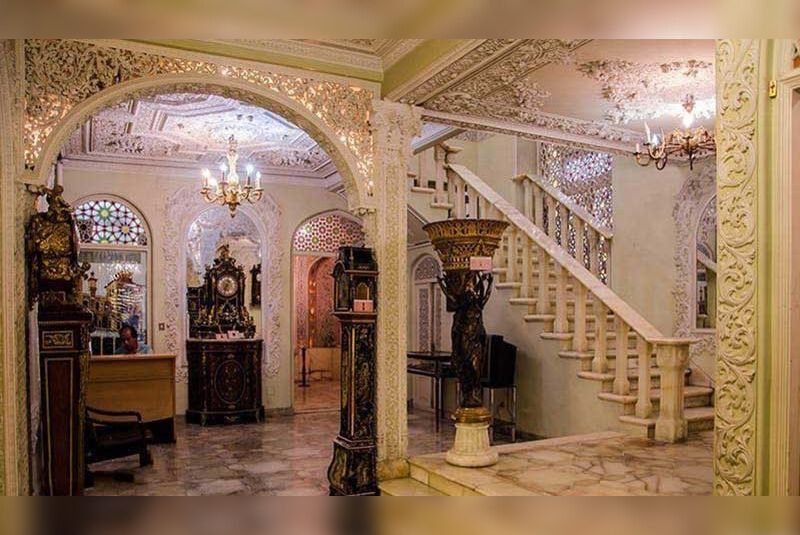
Moving on from the ground floor, visitors ascend to the first floor of the museum, where they are greeted with a collection of old European clocks dating from the 17th to the 20th century. This section showcases various types of mechanical clocks, including mantel clocks, pendulum clocks, table clocks, wall clocks, and stand clocks. These timepieces are not only functional but also adorned with intricate artistic decorations, incorporating sculptural elements, enamelwork, mosaics, and more. The fusion of art and horology is beautifully displayed in this section.
Within the first-floor exhibits, visitors will also discover personal timepieces once owned by prominent figures, as well as watches presented as gifts to politicians during their foreign travels. Among the notable clocks is a pocket watch from 1934, which was crafted in Tehran's arsenal and features a carved image of Pahlavi I. Additionally, a French mantel clock made of bronze and gold captures viewers' attention, with the figure of the Greek epic poet Homer adorning the timepiece in the style of Louis XVI.
The first floor also houses the Esfahani Room, a meticulously reconstructed space that took three years to complete. Designed by the Rouhani brothers, this room draws inspiration from the exquisite architecture of the Supreme Qapu Palace in Isfahan. Its copper and gold roof made up of 99% copper and 1% gold, boasts stunning Tangbari art, a technique prevalent during the Safavid era. The walls feature intricate plasterwork, while the glass is designed to prevent insects from entering. Notably, the lower part of the room showcases a plaster painting known as the Creation Painting, created by Master Isa Khan Bahadori, a student of Kamal-ol-Molk.
| Discover: Tehran Post & Communications Museum
Second Floor
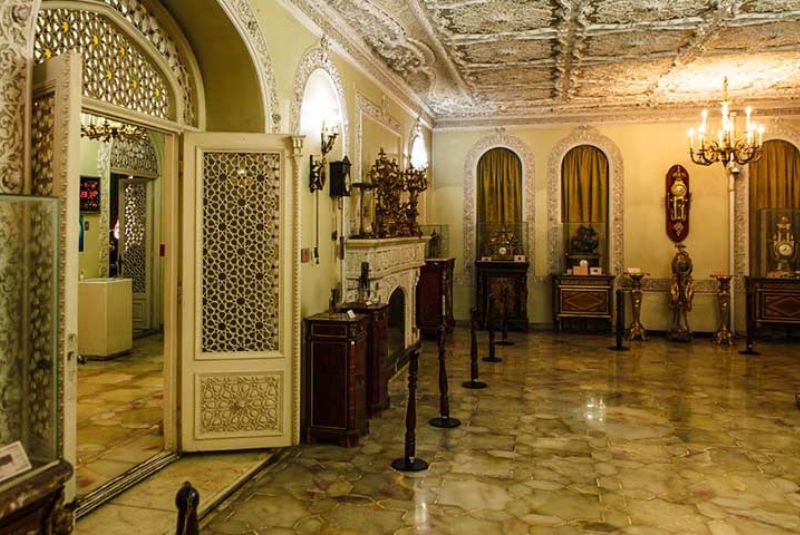
Continuing to the second floor, visitors encounter the works of Houshang Foroutan, an artist who uses parts of old, unused watches to create captivating collages. Foroutan began his artistic endeavor in 1988, and his works have evolved over time, becoming increasingly complex and intriguing. Some of his creations have even been exhibited in American cities.
The second floor also showcases a circular display featuring watch repair tools, such as watchmaking knives, watchmakers' loupes, oil needles, pliers, and other essential instruments. Additionally, wristwatches, pocket watches, and customized timepieces are exhibited on this floor. Noteworthy among these exhibits are time-stamping clocks used on railroads during the late 18th century. These clocks required a special key, which employees used to record their entry and exit times on paper tapes inside the device.
Furthermore, the second floor features watches with historical significance, including sundials belonging to Naser al-Din Shah, Ahmad Shah Qajar, and Muzaffar al-Din Shah of the Qajar dynasty. The section also showcases documents and instruments related to the Jalali calendar, an ancient Iranian calendar, as well as an astrolabe, an astronomical instrument used in ancient times. Visitors can also explore the celestial sphere, a hypothetical sphere that was once employed to measure time. Additionally, replicas of historical Iranian documents, such as the Bisotun inscription, and various ethno-religious calendars, including Hebrew, Zoroastrian, Armenian, and Kurdish calendars, are on display.
Finally, the museum proudly exhibits watches donated by famous figures, including Jamshid Mashayekhi, Mohammad Ali Keshavarz, Davoud Rashidi, Mostafa Rahmandoust, Dr. Hesabi, Shahid Avini, Shahid Mehdi Bakri, and others. These timepieces serve as a testament to the cultural and historical significance of the museum.
| Suggestion: Omidvar Brothers Museum - A Gateway to World Cultures
Time Museum Cafe
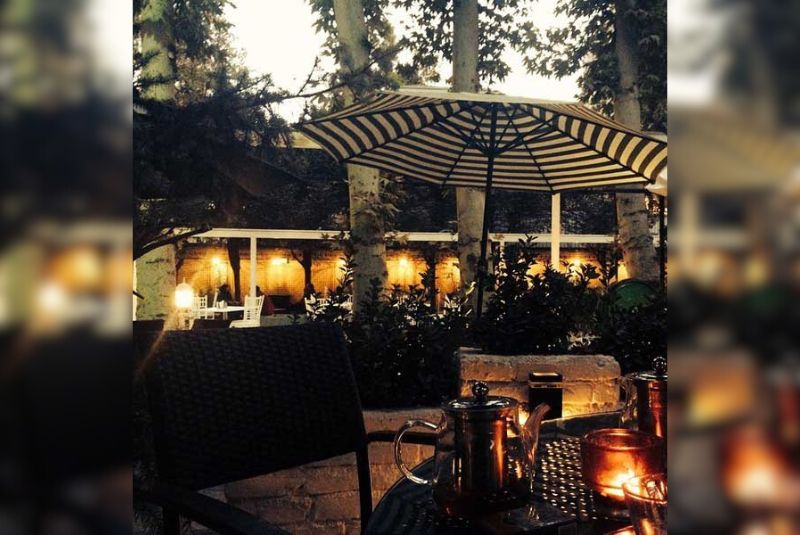
Ribar Restaurant Café, located within the Tehran Time Museum, stands out as one of the finest outdoor cafés in the city. Upon arrival, the café's beautiful layout and design create an immersive environment. With a capacity for around 60 people, the café boasts an extensive and diverse menu, including Alfredo, Caesar salad, natural juices, omelets, lenses, crepes, jams, and more.
| Also read about: Iranian Art Museum Garden
Tehran Time Museum Location
Tehran Time Museum address is Parzin Baghdadi Crossroads, Shahid Fallahi (Zaferaniyeh) Street, Valiasr Avenue, Tehran, Iran.
Attractions Nearby Tehran Time Museum
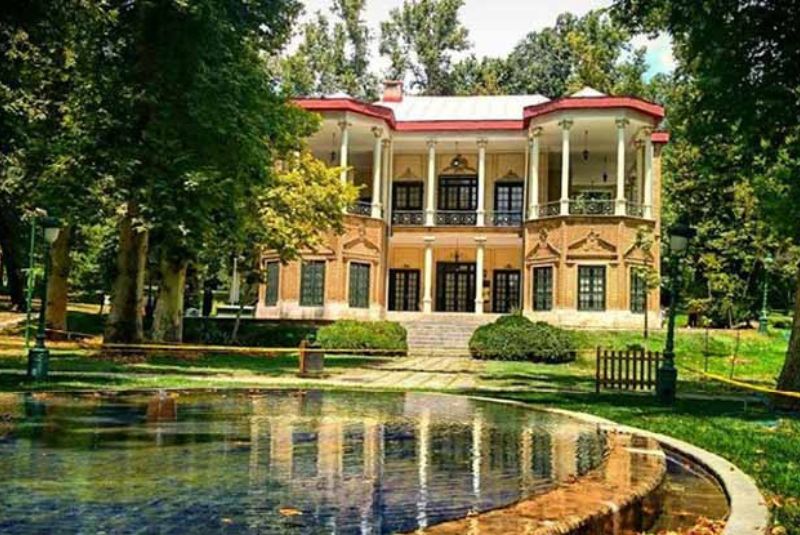
The Tehran Time Museum location is in a famous neighborhood, making it easily accessible for visitors. In close proximity to the museum, you'll find a variety of attractions including:
- Sa'ad Abad Palace: The Sa'ad Abad Palace is a magnificent complex consisting of 18 palaces within a sprawling 300-acre garden. These palaces served as residences for Qajar and Pahlavi kings.
- Niavaran Palace Complex: Another notable attraction close to the museum is the Niavaran Palace Complex. This complex encompasses several stunning palaces and gardens, showcasing the luxurious lifestyle of the royal family.
- Tajrish Traditional Bazaar: Tajrish Bazaar, located in the Tajrish neighborhood, is a bustling marketplace offering a wide array of goods and crafts.
- Mellat Park: A short distance from the museum, Mellat Park is an expansive green space where visitors can unwind and enjoy nature.
- Valiasr Street: Valiasr Street, one of Tehran's major thoroughfares, is renowned as the longest street in the middle east and lined with shops, cafes, and restaurants.
- Cinema Museum of Iran and Ferdows Garden: The Cinema Museum of Iran, located in Ferdows Garden, is a haven for artists and cinema enthusiasts. The garden houses cinema halls, cafes, and a lush environment, providing a delightful setting to explore the rich history of Iranian cinema.
| Also might be interesting: Malek National Library and Museum
How to Get to Tehran Time Museum
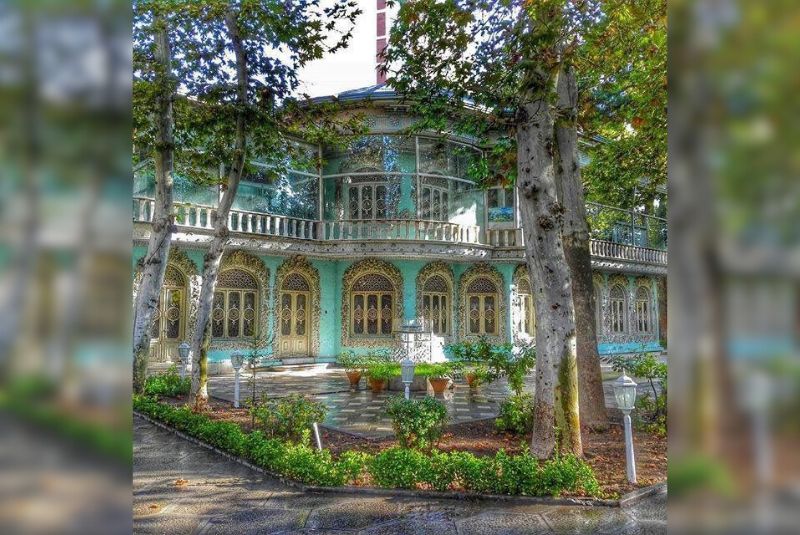
There are several convenient ways to reach the Tehran Time Museum:
By Metro:
The closest metro station to the museum is the Tajrish Metro Station (Red Line). From there, you can take a taxi or use the BRT to reach the beginning of Zaferaniyeh Street. A pleasant walk from there will lead you directly to the museum.
| Read more: Tehran Metro - Lines, Stations, and More (2024)
By Bus:
You can access the museum through the BRT system of Rah Ahan Railway-Tajrish Square. Simply board the BRT and alight at Zaferaniyeh station. From there, it's just a five-minute walk to Baghdadi's Parzin intersection, where the Time Museum is located.
By Car:
If you are driving your own car or using a taxi service, you can follow this route: Take Valiasr Street and exit onto Zaferanieh Street. This will guide you towards the Time Museum.
| Read more: Saba Home Museum - Iran's Melodic Echoes
Entrance Fees + Opening Hours

The Tehran Time Museum in Iran is open every day from 9 A.M to 4 P.M except Fridays and National Holidays. The museum's entrance fee is 20000 Tomans.

Bottom Line
The Tehran Time Museum was established in 1999 and recognized as a national monument in 2003. As the first museum of its kind, it showcases a diverse collection of clocks, watches, and measuring devices that span the ages. From ancient wonders that mesmerize with their intricate mechanisms and craftsmanship to modern timepieces we are familiar with today.
The Tehran Time Museum not only serves as a hub for preserving and displaying historical artifacts but also provides an enjoyable recreational experience. So, if you are visiting Tehran, make sure to add the Tehran Time Museum to your itinerary and discover the wonders that await you.
Share your story!
Comment below and let us know about your Experience.
Your story inspires others!


Comment
Leave a Comment